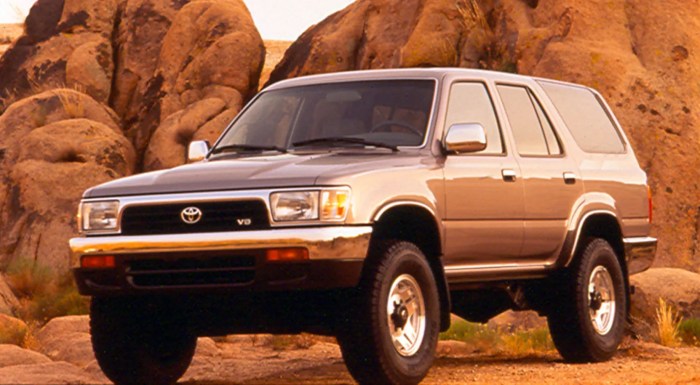How the Toyota 4Runner Has Evolved Over the Years – The Toyota 4Runner, a name synonymous with rugged reliability and off-road capability, boasts a rich history spanning several decades. From its humble beginnings as a derivative of the Hilux pickup truck to its current iteration as a sophisticated SUV, the 4Runner’s evolution reflects changing consumer demands and technological advancements in the automotive industry. This detailed exploration delves into the key milestones, design changes, and technological improvements that have shaped the 4Runner into the iconic vehicle it is today.
The First Generation (1984-1989): Humble Beginnings as a Hilux-Based SUV: How The Toyota 4Runner Has Evolved Over The Years
The 4Runner’s story begins in 1984 with the introduction of the first generation, a compact SUV built on the chassis of the Toyota Hilux pickup truck. This generation, often referred to as the “first-gen 4Runner,” was a simple, utilitarian vehicle. Its boxy design, featuring a removable rear top, showcased its off-road heritage. It was powered by a 2.4-liter four-cylinder engine, offering decent performance for its time.
This generation established the 4Runner’s reputation for durability and off-road prowess, appealing to those seeking a rugged and reliable vehicle for both urban and off-road adventures. Key features included its high ground clearance, four-wheel-drive system, and simple mechanicals, making it easily maintainable.

Source: hotcarsimages.com
Key Features of the First Generation:
- Hilux-based platform
- Removable rear top
- 2.4-liter four-cylinder engine
- Rugged and reliable design
The Second Generation (1990-1995): Refinement and Increased Comfort
The second-generation 4Runner, launched in 1990, marked a significant shift towards refinement and increased comfort. While retaining its off-road capabilities, Toyota incorporated a more car-like driving experience. The boxy design was replaced with a more rounded, aerodynamic shape. Engine options expanded, including a more powerful V6 engine, providing improved performance and towing capacity. This generation also saw the introduction of more creature comforts, such as improved interiors and enhanced safety features.
The second generation solidified the 4Runner’s position as a versatile vehicle capable of handling both daily commutes and challenging off-road terrains. This generation is often praised for its blend of ruggedness and everyday usability.
Key Features of the Second Generation:
- More aerodynamic design
- V6 engine option
- Improved interior comfort
- Enhanced safety features
The Third Generation (1996-2002): A More Modern Approach
The third-generation 4Runner, introduced in 1996, further refined the formula. It featured a more sophisticated design, incorporating modern styling cues while maintaining its rugged identity. The interior received a significant upgrade, offering more passenger space and improved comfort. Technological advancements included the introduction of more advanced safety features and improved suspension systems. This generation continued to offer a range of powerful engine options, catering to diverse needs and preferences.
The third generation cemented the 4Runner’s reputation as a capable and versatile SUV, appealing to a broader range of consumers.
Key Features of the Third Generation:
- More sophisticated design
- Improved interior space and comfort
- Advanced safety features
- Enhanced suspension systems
The Fourth Generation (2003-2009): A Body-on-Frame Design Continues
The fourth generation (2003-2009) maintained the 4Runner’s body-on-frame construction, emphasizing off-road capability. This generation showcased a more robust and muscular design, further emphasizing its rugged nature. Toyota continued to improve the engine options, offering powerful and fuel-efficient choices. Safety features were further enhanced, incorporating advanced airbags and electronic stability control. This generation continued to appeal to off-road enthusiasts while offering a comfortable and refined on-road driving experience.
The emphasis remained on durability and reliability, hallmarks of the 4Runner brand.
Key Features of the Fourth Generation:, How the Toyota 4Runner Has Evolved Over the Years
- Body-on-frame construction
- Robust and muscular design
- Improved engine options
- Enhanced safety features
The Fifth Generation (2010-Present): Modern Technology and Refinement
The current, fifth-generation 4Runner (introduced in 2010 and receiving updates throughout the years), represents the pinnacle of Toyota’s efforts to balance off-road prowess with modern technology and refined comfort. While retaining its body-on-frame construction, this generation features a more contemporary design, incorporating advanced safety technologies, improved fuel efficiency, and a more sophisticated interior. The 4Runner continues to offer a range of powerful engine options, ensuring that it remains a capable and versatile SUV for diverse driving conditions.

Source: fixdapp.com
This generation showcases Toyota’s commitment to delivering a vehicle that combines rugged capability with modern convenience and safety.
Key Features of the Fifth Generation:
- Modern and refined design
- Advanced safety technologies
- Improved fuel efficiency
- Sophisticated interior
- Powerful engine options
Toyota 4Runner: A Legacy of Reliability and Off-Road Capability
The Toyota 4Runner’s evolution is a testament to its enduring appeal. From its humble beginnings as a Hilux-based SUV to its current iteration as a sophisticated and technologically advanced vehicle, the 4Runner has consistently delivered on its promise of reliability, durability, and off-road capability. Its enduring popularity speaks to its ability to adapt to changing consumer demands while maintaining its core identity as a rugged and versatile SUV.
The 4Runner’s legacy is built on a foundation of quality, performance, and unwavering dependability, making it a true icon in the automotive world.
Frequently Asked Questions (FAQs)
- What is the best year for a Toyota 4Runner? This is subjective and depends on individual needs and preferences. However, many enthusiasts consider the third and fourth generations to be particularly reliable and capable.
- Is the Toyota 4Runner a good off-road vehicle? Yes, the 4Runner is renowned for its off-road capabilities, particularly the body-on-frame models. Its high ground clearance, four-wheel-drive system, and robust construction make it suitable for challenging terrains.
- How reliable is the Toyota 4Runner? Toyota 4Runners are generally considered to be very reliable vehicles, known for their longevity and durability.
- What are the common problems with Toyota 4Runners? Like any vehicle, 4Runners can experience issues, but common problems are often related to age and mileage, such as suspension components, electrical systems, and engine components. Regular maintenance can significantly mitigate these issues.
- How much does a used Toyota 4Runner cost? The price of a used 4Runner varies greatly depending on the year, model, condition, and mileage. Researching current market prices is recommended.
References
- Toyota 4Runner Official Website
- Edmunds Toyota 4Runner Reviews
- Car and Driver Toyota 4Runner Reviews
Call to Action
Ready to experience the legendary Toyota 4Runner for yourself? Visit your local Toyota dealership today for a test drive and discover the perfect 4Runner to suit your needs and adventures!
Detailed FAQs
What is the 4Runner’s most significant design change?

Source: amazonaws.com
Arguably, the shift from a body-on-frame design to a unibody design (depending on the generation) represents a significant change, impacting handling and off-road capabilities.
Which 4Runner generation is considered the most reliable?
This is subjective and depends on individual experiences, but certain generations are often cited for their reliability based on owner reports and independent studies. More specific research into particular model years is recommended.
What are the main differences between the 4Runner and the Toyota Land Cruiser?
While both are SUVs with off-road capabilities, the Land Cruiser is generally larger, more luxurious, and commands a higher price point. The 4Runner offers a more compact and arguably more affordable alternative.
